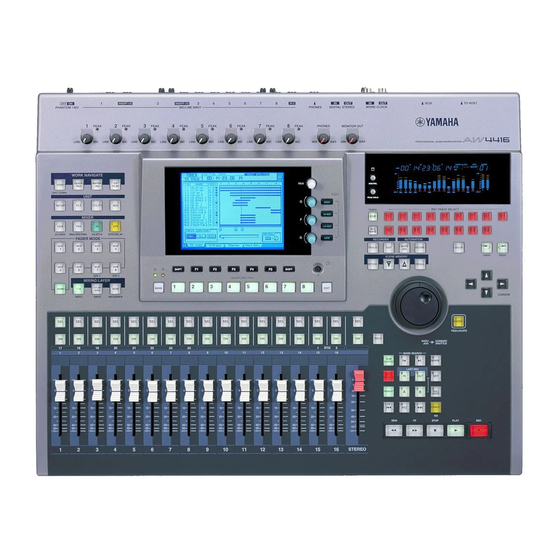Yamaha AW4416 Учебное пособие - Страница 5
Просмотреть онлайн или скачать pdf Учебное пособие для Музыкальный инструмент Yamaha AW4416. Yamaha AW4416 34 страницы. Installing an internal hard disk
Также для Yamaha AW4416: Дополнительное руководство (1 страниц), Дополнительное руководство (20 страниц), Дополнение к руководству (48 страниц), Руководство (3 страниц)

Tutorial—Laying Down the Basic Tracks
Laying Down the Basic Tracks
Although the basic tracks you'll use to assemble the "So Fine" mix have already
been recorded for you (of course you can add your own tracks, if you like), let's
take a moment to discuss the initial recording process.
The basic steps introduced here may not apply if you're recording something very
"avant-garde," but if you're laying down a song or instrumental piece with a fairly
standard arrangement, here are a few issues to keep in mind:
Rhythm First!
Since the rhythm parts define the tempo and "groove" of the music, it makes
sense that they should be recorded first so that the musicians who will be over-
dubbing the subsequent parts — lead guitar, lead vocal, chorus, etc. — will have
something to lock onto. Of course this isn't necessary if the piece to be recorded
consists of just one person strumming a guitar and singing or, for that matter, if
you'll be recording an entire ensemble in one take. But if you'll be recording your
masterpiece track-by-track or at least section-by-section — whether it's because
like most of us you're recording with limited studio space and resources, or sim-
ply because you're a perfectionist who demands total creative control at all times
— start with the rhythm. The first rhythm part to be recorded could simply be
drums and/or percussion alone, drums and bass, or drums plus bass and a rhythm
keyboard or guitar part.
Separation
Remember that the more instruments you record via microphones at the same
time, the more you need to think about separation (or "isolation" depending on
whom you talk to). Once again, there are no hard-and-fast rules: if you'll be
recording an entire rhythm section or ensemble with one stereo microphone pair,
for example, separation is a non-issue — but instrument layout and microphone
placement are critical! But assuming you want all instruments cleanly recorded
on separate tracks so you can do all your spatial arranging and processing later
on, you'll need to ensure that leakage between instruments and microphones is
minimized. How? Physical separation is the best way. Record different instru-
ments in different rooms, if possible (this corresponds to using "isolation booths"
in a recording studio), or use baffles to reduce leakage when recording more than
one source in the same room. Directional microphones are a good idea, and
close-miking can be a big help. The only way to achieve total separation, though,
is to overdub acoustic sources one-at-a-time. Even then, you'll probably end up
with a little leakage from the vocalist's headphones, for example. Line sources,
naturally, do not present a problem.
A little leakage is not a big problem, though, so don't let it bog you down. Listen
carefully to the individual "So Fine" tracks and you'll hear what we mean.
5
— Tutorial
